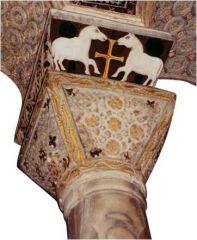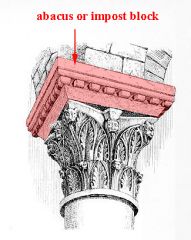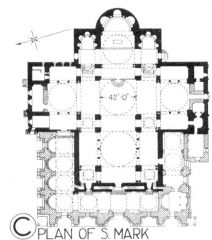![]()
![]()
![]()
Use LEFT and RIGHT arrow keys to navigate between flashcards;
Use UP and DOWN arrow keys to flip the card;
H to show hint;
A reads text to speech;
7 Cards in this Set
- Front
- Back
|
How did Byzantine come into existence, when and by whom was it finally conquered?
|
How - Gradually emerged after Diolletion split imperial Roman administration between east & west.
When - May 11, 330 CE, Foundation of Constantinople Conquered - Ottoman Turks 1453 |
|
|
How do Byzantine mosaics differ from their Roman predecessors?
|

Roman mosaics were almost entirely on floors.
Byzantine - were placed on walls and ceilings, could be made of less durable materials particularly glass & precious metals. |
|
|
What do you know about Byzantine column capitals?
|

Endless variety
Protomai - featured animal forms Finished by local builders on site |
|
|
What is an Impost Block and in which architectural style did it occur first?
|

Block above the column, often inverted truncated pyramid.
(A stone slab w/ the shape of a truncated, inverted pyramid that is placed between a capital & the architectural member) Byzantine Empire |
|
|
What are windswept capitals and in which architectural style were they developed?
|

with carved acanthus leaves similar to those on Corinthian capitals,but the leaves were flat, had pointed lobes, and leaned to one side as if blown by the wind.
- Byzantine Empire |
|
|
Draw a Quincunx plan church and label its elements
|

|
|
|
Name 5 characteristics of Byzantine churches
|
- Multiple domes and half domes
- centralized plan, including Greek cross plan (Quincunx plan) - Cross in square plan - Separation of church interior into sanctuary and nave - vaults - Predominately brick construction - impost blocks - Mosaics often with gold & Lapis-lazuli |

